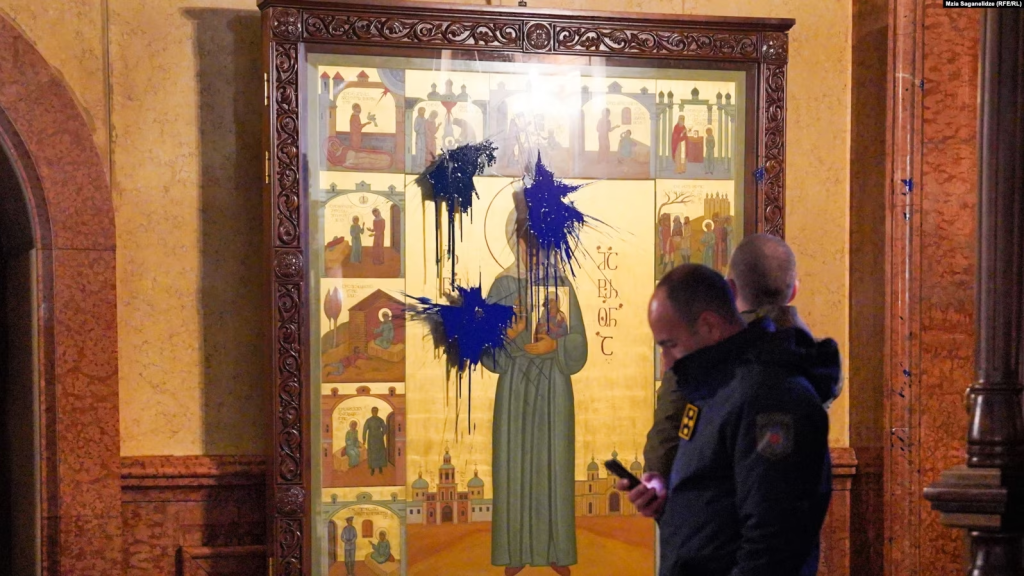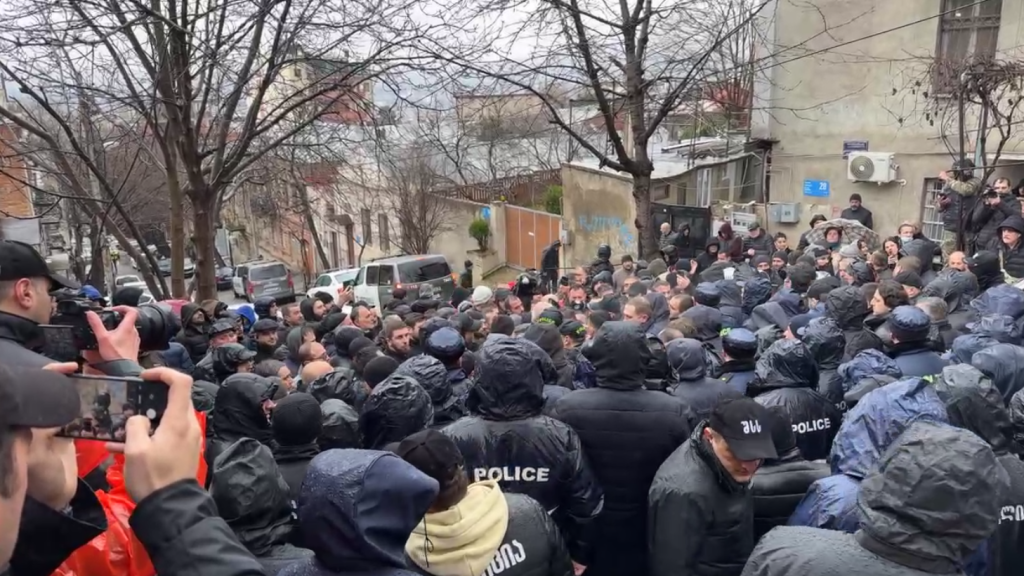The discovery of an icon in the capital city’s main Orthodox Cathedral that bears the image of the late Soviet dictator, Joseph Stalin, raised uncomfortable questions about the lenient attitude of Georgia’s leading religious institution towards Stalin and the influence of the Russian Orthodox Church.
What happened?
On Christmas Day, January 7, civic activists uploaded images on social media that showed the icon of the St. Matrona of Moscow in Tbilisi’s Holy Trinity Cathedral. On the frieze of the main icon, one of the fragments depicting the saint’s life shows Joseph Stalin taking her blessing.
Giorgi Kandelaki, who researches Stalinism revival at the Soviet Past Research Laboratory (SovLab), wrote
that depiction of Stalin, “the initiator of the destruction of independent Georgia, murderer of thousands of clerics and creator of the Soviet totalitarian system,” was a “new success of the Russian information warfare” in Georgia.
Civic-minded Georgians, theologians, and some clerics reacted indignantly to the news.
Who was Matrona of Moscow?
“Blessed Matrona” lived in Moscow at the turn of the 20th century. Blind from birth, she was said to possess the powers of healing. The Russian Orthodox Church sanctified her on May 2, 1999. According to the non-canonical legend, Matrona blessed Joseph Stalin as Nazi Germany advanced to the Soviet capital and prophesized that if he remained in Moscow and restored the Church to its glory, the motherland would be saved. This episode is depicted on the said icon.
The iconography of St. Matron and Stalin originates in Russia, is relatively recent, and has proven controversial even there. The Russian media reported that an icon of St. Matrona and Stalin was first displayed in a Staint-Petersburg church in 2008 but caused uproar in the parish, “after which the [Russian] Orthodox Church leadership denounced the priest of the church and dismissed him from his duties.”
How did the St. Matrona Icon turn up in Tbilisi Cathedral?
Soon after the controversy erupted, Irma Inashvili, the leader of the Patriots’ Alliance of Georgia, a pro-Russian and anti-Western with close ties to the Kremlin, said they had ordered the icon to be painted in Russia and gifted it to the Cathedral. Inashvili said Stalin’s depiction does not mean he is the object of adulation, and there is no reason to assume that the icon presents him in a positive light since “the dragon, i.e. the evil incarnate, is also depicted on the icons of St. George.”
What did the Orthodox Church say?
The Head of Public Relations of the Georgian Orthodox Church (GOC), Andria Jaghmaidze, dismissed the concerns. Picking on semantic differences, he said the activists misled the public when saying it was “the icon of Stalin” and argued that the depiction of Stalin “does not mean that Stalin is the object of adulation.” He echoed Inashvili and went on to argue that figures that are perceived negatively by the Church and dogma, such as the Roman Emperor Diocletian are depicted on the icons. Gaius Aurelius Valerius Diocletianus, was a Roman emperor in III-IVcc. A.D. and is at times depicted being stricken by St. George in Georgian iconography.
Theologians say the comparison is obviously misleading since the forces of evil are depicted on icons as being vanquished by Saints, while Stalin is depicted as being blessed by the object of adulation – St. Matrona – which is also repeated in the accompanying inscription.
Stalinist revival?
Civic activists have been pointing to the worrying trend of the revival of Stalin as a revered public and political figure in Georgia, which coincides with the glorification of the Soviet dictator in Russia in the context of that country’s increased militarization and aggressiveness.
A 2021 survey by CRRC, a pollster, which spoke to 3,024 Georgians – a representative sample – showed 66% agreeing completely or partially with the statement that “a patriotic Georgian must be proud that Stalin was Georgian.” 16% were neutral and 28% disagreed completely, or partially. More than 60% agreed that Stalin’s rule had “both positive and negative sides” with only 9% disagreeing. While 52% conceded that “Stalin was a tyrant responsible for the deaths of millions”, two-thirds believed that “Stalin was a wise leader who led the USSR to strength and prosperity.”

Importantly, a significant part of the surveyed – 41% – were shown to believe that Stalin was a religious person, showing an impact of the post-WWII Soviet and modern Russian propaganda. A viciously anti-religious Soviet regime persecuted religious figures from its early days, killed, imprisoned, and exiled hundreds of priests and bishops of the Georgian Orthodox Church, and destroyed and damaged religious buildings.
SovLab said in its statement following the incident that “thousands of clergymen were executed in Georgia, most of them leaders and parishioners of the Georgian Orthodox Church, especially during the anti-Soviet uprising of 1924 and then during the Stalinist terror of 1937-1938”. SovLab says since 2012, twelve new statues of Stalin have been erected in Georgia.
Legend of “Stalin the Savior” and Russian Church as “Soft Power” Tool
During the most difficult moments of WWII, Stalin appealed to the imperial narratives and integrated religious undertones in mobilizing citizens for the “Great Patriotic War.” 1943-1948 are considered pivotal in restoring the Russian Orthodox Church (RoC), after the huge wave of repressions in the 1920s that took the lives of – by some estimates – up to 80 thousand clergymen and believers. In 1943, the Russian Orthodox Church also officially recognized the independence of the Georgian Orthodox Church (GoC), which it canceled in 1801-1811 (the Georgian Orthodox Church restored its independence in 1917).
Although restored, the RoC and other Churches were subordinated to the authoritarian state and the personality cult of Stalin, through the office of the KGB-controlled “Committee on Religious Issues.” The penetration of security apparatus in the RoC and in GoC was pervasive. It continues in Russia through Patriarch Kirill, who is widely considered to also belong to the security cadre. The Russian Orthodox Church has been vocally supporting Putin’s expansionist and revanchist policies, including the ongoing war in Ukraine waged by Russia.
In Georgia, many clerics and hierarchs echo the RoC anti-Western narratives that oppose the concept of “family values” to universal human rights, and preach intolerance and sometimes violence against minorities, especially the LGBT community.
Further Controversy
In a follow-up to the incident of January 9 Nata Peradze, civil activist and founder of the “Talgha” (Wave) movement, threw blue paint on the icon of St. Matrona in an act of protest and uploaded the photo on social media. The police said yesterday that it opened an inquest into this “actor of minor hooliganism.” Peradze said she received threats via phone and online messages and had contacted the police.

The pro-Kremlin and anti-western Conservative Movement/Alt-Info, which has orchestrated violent pogroms on LGBT community in the past, marched on the Peradze’s home on January 10 and confronted the police cordon. After calling on the government to stop protecting Peradze and the others like her and to punish the blasphemous acts, the group has disbanded.
The GoG Patriarchate announced it was restricting access to the Holy Trinity for journalists without prior accreditation, to “avoid further misunderstandings and tensions.”
Later during the day of January 10, photos emerged of the icon, apparently cleaned of the blue paint and moved to a more prominent position at the Holy Trinity Cathedral.

Meanwhile, the Chair of the Parliament’s Legal Affairs Committee Anri Okhanashvili, at a briefing on January 10 announced the plans of the ruling Georgian Dream party to introduce the criminal liability for insulting religious buildings and objects, and for any act inciting hatred on religious grounds. “This applies to both Christian Orthodox and other religious buildings, for example: mosques, synagogues, Catholic and other churches,” he said.
Patriarchate calls for alteration of the icon
On January 11, the Patriarchate of Georgia issued a statement urging the modification of the icon of St. Matrona of Moscow. According to the Patriarchate, the icon has been a source of recent heated debates and confrontations, taking on a political dimension. The statement also highlights that the icon has become “the object of completely unjustified and insulting actions.”
The Patriarchate emphasizes that, according to canonical rules of iconography, an icon can depict real-life historical experiences of the saint, including their interactions with individuals. The statement clarifies: “However, this does not imply that the icon glorifies these persons or accords them any dignity. Instead, such details serve as a reflection of the unequivocal facts related to the saint.”
The Patriarchate of Georgia asserts: “Since the meeting of I. Stalin with St. Matrona is not included in the canonical text of her life due to insufficient evidence and is not recognized by the Russian Church, which canonized her and conducted a special study on this issue, it is necessary to change the mentioned episode and consider other details related to the canonicality of the iconography.”
The Patriarchate calls upon Irma Inashvili, to implement the required modifications, or it will take it upon itself to make the necessary alterations. Inashvili has already agreed to make the changes.
This post is also available in: ქართული Русский
